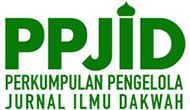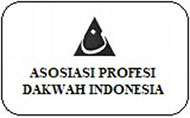Islam and Traditional Fabrics: Symbolic Da’wah in Sambas Malay Weaving Motifs, West Kalimantan
Abstract
This article aims to analyze symbolic da'wah through the weaving motifs of Malay Sambas, West Kalimantan. This study uses an interpretive paradigm with a semiotic method. The data sources in this study were 22 motifs of Sambas Malay woven fabric. Data was obtained through observation and interviews. The data obtained were then analyzed using the semiotic triangle meaning model of Charles Sander Peirce. This study finds that the woven fabric motif is formed through a long process and closely relates to the socio-cultural construction of the Sambas Malay society. At this level, the Sambas Malay weaving motif is created from three elements: beauty, cultural identity, and the ethnoreligious reality of the Sambas Malay society, and efforts to internalize Islamic teachings in Sambas Malay life through the meaning and symbolic message of the motif. Based on these findings, it can be concluded that the Sambas Malay weaving motif is not only a cultural product of the Sambas Malay society but also a symbolic da’wah medium in the Sambas Malay society through a cultural approach.
Keywords
Full Text:
PDFReferences
Abdullah, A., Wahid, J., Salleh, B. M., & Al-Ansi, N. A. (2022). A River That Flows Forever: The Lost Glory of Malay Waterways. Journal of Asian Geography, 1(1), 34-39.
Adnan, Suriadi, Mujahidin, Jayadi, & Mursidin. (2019). Cultural Da’wah and Islamic Education Values in Antar Ajong Tradition of People in Melayu Sambas West Kalimantan. KARSA: Journal of Social and Islamic Culture, 27(1), Article 1. https://doi.org/10.19105/karsa.v27i1.1537
Airriess, C. A. (2003). The Ecologies of ‘Kuala’ and ‘Muara’ Settlements in the Pre-Modern Malay Culture World. Journal of the Malaysian Branch of the Royal Asiatic Society, 76(1), 81–98.
Alfath, E. D. (2015). Potential Conflict between the Malay and the Dayak Ethnic Groups in the Hinterland Region of West Kalimantan. Makara Human Behavior Studies in Asia, 19(1), 52-62. https://doi.org/10.7454/mssh
Anshari, E. S. (2005). Wawasan Islam: Pokok-Pokok Pikiran tentang Paradigma dan Sistem Islam. Gema Insani.
Anwarudin, I. (2010). Nilai Budaya dalam Tradisi Tenun Sambas sebagai Sumber Pembelajaran Pendidikan IPS [Tesis, Universitas Pendidikan Indonesia]. http://repository.upi.edu
Barnard, M. (2013). Fashion as Communication. Routledge. https://doi.org/10.4324/9781315013084
Chua, L. (2007). Fixity and Flux: Bidayuh (Dis)engagements with the Malaysian Ethnic System. Ethnos, 72(2), 262–288. https://doi.org/10.1080/00141840701387937
Collins, James. T. (2005). Bahasa Melayu Bahasa Dunia. Yayasan Obor Indonesia.
Deledalle, G. (2000). Charles Sanders Pierce’s Philosophy of Sign: Essays in Comparative Semiotics. Indiana University Press.
Din, M. A. O. (2011). Asal Usul Orang Melayu: Menulis Semula Sejarahnya (The Malay Origin: Rewrite Its History). Jurnal Melayu, 7, 1-82.
Direktorat Jenderal Kebudayaan. (1983). Album Tenun Tradisional: Aceh, Sumatera Barat, Sulawesi Selatan, Nusa Tenggara Barat,. Departemen Pendidikan dan Kebudayaan Republik Indonesia.
Fitriyani. (2002). Sistem Pewarisan pada Masyarakat Hukum Adat Melayu Sambas Kabupaten Sambas Kalimantan Barat [Tesis, Universitas Diponegoro]. http://eprints.undip.ac.id/10863/
Frith, T. (2000). Ethno-Religious Identity and Urban Malays in Malaysia. Asian Ethnicity, 1(2), 117–129. https://doi.org/10.1080/713611705
Handayani, M. A. (2020). Symbolism and Islamic Values in Students’ Reog Stage at Muharam Celebration. Jurnal Da’wah Risalah, 31(2), 183-198. https://doi.org/10.24014/jdr.v31i2.11255
Haryanto, J. T. (2012). Interaksi dan Harmoni Umat Beragama. Walisongo: Jurnal Penelitian Sosial Keagamaan, 20(1), 211-234. https://doi.org/10.21580/ws.20.1.197
Hidayat, N. (2018). Dakwah berbasis kearifan lokal: Study etnografi terhadap tradisi dzikir Nazam Al-Barzanji sebagai media dakwah di Desa Mulia Kecamatan Teluk Keramat Kabupaten Sambas Provinsi Kalimantan Barat [Tesis, Universitas Islam Negeri Sunan Ampel]. http://digilib.uinsby.ac.id/25114/
Hong, S.-J. (2016). The social formation and cultural identity of Southeast Asian frontier society: Focused on maritime Zomia as frontier in connection with the ocean and the inland. Journal of Marine and Island Cultures, 5(1), 28–35. https://doi.org/10.1016/j.imic.2016.05.004
Ibrahim. (2018). Contiguity of Islam and Local Tradition on the Hinterland Malays of West Kalimantan. Ulumuna, 22(2), 277-300. https://doi.org/10.20414/ujis.v22i2.286
Ishak, Mohd. S. bin H., & Abdullah, O. C. (2012). Islam and the Malay World: An Insight into the Assimilation of Islamic Values. World Journal of Islamic History and Civilization, 2(2), 58–65.
Jappy, T. (2013). Introduction to Piercean Visual Semiotics. Bloomsbury Publishing Plc.
Junaidi. (2014). Islam dalam Jagad Pikir Melayu. Buletin Al-Turas, 20(2), 46-56. https://doi.org/10.15408/bat.v20i2.3744
Junita, Mualimin, & HM, A. (2021). Dakwah Kultural dalam Tradisi Maantar Jujuran Suku Banjar di Samuda Kotawaringin Timur. Jurnal Dakwah Risalah, 31(2), 138-153. https://doi.org/10.24014/jdr.v31i2.10581
Kartiwa, S. (2007). Ragam Kain Tradisional Indonesia: Tenun Ikat. Gramedia Pustaka Utama.
Kaspullah. (2015). Pendidikan Keluarga bagi Pasangan Pengantin dalam Tradisi Pernikahan Masyarakat Melayu Sambas [Disertasi]. Universitas Islam Negeri Sunan Gunung Djati.
Kurniawan, S., & Suratman, B. (2018). Bertani Padi Bagi Orang Melayu Sambas: Kearifan Lokal, Nilai-Nilai Islam, dan Character Building. Analisis: Jurnal Studi Keislaman, 18(2), 189-210. https://doi.org/10.24042/ajsk.v18i2.3132
Lathifah, A. (2018). Turun Melayu: Konstruksi Identitas Orang Dayak Muslim di Desa Kuala Rosan Kalimantan Barat. Endogami: Jurnal Ilmiah Kajian Antropologi, 2(1), 80-87. https://doi.org/10.14710/endogami.2.1.80-87
Lim, K. H. (2010). How Malay proverbs encode and evaluate emotion? A paremiological analysis. SARI: International Journal of The Malay World and Civilization, 28(1), 57–81.
Martin, D. (2014). Gender, Malayness and the Ummah: Cultural Consumption and Malay-Muslim Identity. Asian Studies Review, 38(3), 403–421. https://doi.org/10.1080/10357823.2014.929635
Masrura, W., Sabari, & Sunandar. (2020). Pantun Melayu Sambas sebagai Media Dakwah: Studi dalam Tradisi Pulang Memulangkan Di Seranggam Sambas. Jurnal SAMBAS : (Studi Agama, Masyarakat, Budaya, Adat, Sejarah) Journal of Religious, Community, Culture, Costume, History Studies, 3(1), 1-12.
Mee, W. (2010). A traffic in Songket: Translocal Malay identities in Sambas. Journal of Southeast Asian Studies, 41(2), 321–339. https://doi.org/10.1017/S002246341000007X
Mee, W. (2012). The Ebb and Flow of Popular Islamic Music Forms: Zikir Maulud Amongst Sambas Malays. Asian Journal of Social Science, 40(2), 203–233. https://doi.org/10.1163/156853112X640143
Mee, W. (2017). Rowing ‘at home’ and ‘away’: Sport, heritage and identity in the Malay world. Identities, 24(4), 474–492. https://doi.org/10.1080/1070289X.2016.1200051
Mualimin. (2020). Makan Besaprah: Pesan Dakwah dalam Bingkai Tradisi pada Masyarakat Melayu Sambas, Kalimantan Barat. Ath Thariq Jurnal Dakwah Dan Komunikasi, 4(1), 1-19. https://doi.org/10.32332/ath_thariq.v4i1.2017
Mualimin, Yunaldi, A., Sunandar, & Alkadri. (2018). Cultural Da’wah of Antar Pinang Pulang Memulangkan Tradition in Sambas Malay Society, West Kalimantan. Ilmu Dakwah: Academic Journal for Homiletic Studies, 12(2), 201-213. https://doi.org/10.15575/idajhs.v12i2.1909
Musa, P. (2010). Tahapan-Tahapan Sejarah Sambas [Makalah]. Dies Natalis STAI Sambas tahun 2010, Sambas.
Nagata, J. A. (1974). What Is a Malay? Situational Selection of Ethnic Identity in a Plural Society. American Ethnologist, 1(2), 331–350. JSTOR.
Natalia, D. (2019). Kajian Tenun Songket Sambas [Skripsi, Universitas Sebelas Maret]. https://digilib.uns.ac.id/dokumen/detail/75720/Kajian-Tenun-Songket-Sambas
Nayan, N. M., Jones, D. S., Bahaluddin, A., Ghani, I., & Rahman, N. A. (2020). Designating Urban Rivers as National Heritage: A case study of Sungai Kelang and Sungai Gombak, Kuala Lumpur, Malaysia. IOP Conference Series: Earth and Environmental Science, 409(1), 012035. https://doi.org/10.1088/1755-1315/409/1/012035
Nurhikmah, Said, N. M., Malik, A., & Syam, M. T. (2021). Adaptation of Da’wah in the Tradition of Tolak Bala in the Community of Parepare City. Jurnal Dakwah Risalah, 32(1), 20-39. https://doi.org/10.24014/jdr.v32i1.12857
Purnama, R., Utami, C., & Prihatiningtyas, N. C. (2020). Eksplorasi Etnomatematika dalam Motif Tenun Kain Lunggi Sambas Kalimantan Barat dan Implikasinya terhadap Pembelajaran Matematika. Variabel, 3(1), 36–48. https://doi.org/10.26737/var.v3i1.1307
Risa. (2014). Islam di Kerajaan Sambas antara Abad XV-XVII: Studi Awal tentang Islamisasi di Sambas. Khatulistiwa, 4(2). 105-116. https://doi.org/10.24260/khatulistiwa.v4i2.244
Risa. (2016). Perkembangan Islam di Kesultanan Sambas. Ombak.
Roberts, P. (2012). Between Frontiers: Nation and Identity in a Southeast Asian Borderland. The International History Review, 34(1), 199–201. https://doi.org/10.1080/07075332.2012.667645
Setiyawan, A. (2012). Budaya Lokal dalam Perspektif Agama: Legitimasi Hukum Adat (‘Urf) Dalam Islam. ESENSIA: Jurnal Ilmu-Ilmu Ushuluddin, 13(2), 203–222. https://doi.org/10.14421/esensia.v13i2.738
Sobur, A. (2013). Semiotika Komunikasi. Remaja Rosdakarya.
Solihin, S. M. (2017). Integration of Malay Culture Identity with Islamic Religion. Journal of Malay Islamic Studies, 1(2), 121-128. https://doi.org/10.19109/jmis.v1i2.3841
Tamrin, H. (2017). Enkulturisasi dalam Kebudayaan Melayu. Al-Fikra: Jurnal Ilmiah Keislaman, 14(1), 98-148. https://doi.org/10.24014/af.v14i1.3903
Thamrin, H. (2013). Kearifan Lokal dalam Pelestarian Lingkungan (The Local Wisdom in Environmental Sustainable). Kutubkhanah: Jurnal Penelitian Sosial Keagamaan, 16(1), 46-59.
Venus, A. (2015). Filsafat Komunikasi Orang Melayu. Simbiosa Rekatama Media.
Vera, N. (2014). Semiotika dalam Riset Komunikasi. Ghalia Indonesia.
Wahab, A. (2017). Islamic Values of Social Relation in Besaprah Tradition of Sambas Society: The Case of Post-Conflict Malay-Madura in 1999-2017. Walisongo: Jurnal Penelitian Sosial Keagamaan, 25(2), 383–400. https://doi.org/10.21580/ws.25.2.1339
Wu, P.-C. (2015). Looking beyond ethnicity: The negotiation of Chinese Muslim identity in Penang, Malaysia. Asian Ethnicity, 16(1), 78–91. https://doi.org/10.1080/14631369.2013.870838
Yusriadi. (2015). Identitas Orang Melayu di Hulu Sungai Sambas. Khatulistiwa, 5(1).74-99. https://doi.org/10.24260/khatulistiwa.v5i1.267
DOI: http://dx.doi.org/10.24014/jdr.v33i2.19570
Refbacks
- There are currently no refbacks.

This work is licensed under a Creative Commons Attribution-ShareAlike 4.0 International License.
Editorial Office:
2nd Floor, Building of Faculty of Da'wah and Communication, Universitas Islam Negeri Sultan Syarif Kasim Riau. Jl. HR Soebrantas Km 15, Simpangbaru, Tampan, Pekanbaru
Email : jurnalrisalah@uin-suska.ac.id

This work is licensed under a Creative Commons Attribution-ShareAlike 4.0 International License.














